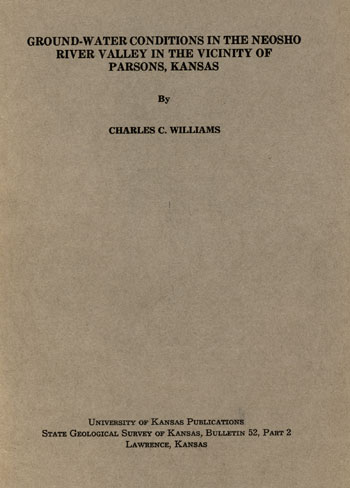Ground-water Conditions in the Neosho River Valley in the Vicinity of Parsons, Kansas
By Charles C. Williams

Originally published in 1944 as Kansas Geological Survey Bulletin 52, Part 2. This is, in general, the original text as published. The information has not been updated.
Abstract
This report presents the results of an investigation of the ground-water conditions in the Neosho river valley near Parsons, Kansas, which was made with special reference to the possibility of developing a supply of water for the Kansas Ordnance Plant. A geological reconnaissance of a part of the valley was supplemented by test drilling and by a pumping test.
It was found that the physical characteristics and thickness of the water-bearing materials comprising the alluvium are quite variable. In general the alluvium is about 35 feet thick. The upper 10 to 30 feet consists of silt and clay and the lower part, ranging in thickness from a few inches to 15 feet, consists of poorly sorted sand and gravel.
Neosho river receives water from the ground-water reservoir which in turn receives recharge from precipitation. Some recharge is supplied to the alluvium by Neosho river in times of flood. In 1942 the water table was less than 10 feet below land surface in most parts of the valley.
A pumping test was made, and from the data obtained it was computed that the alluvium has a coefficient of permeability of about 420 and a specific yield of about 20 percent. It is concluded that during periods of normal precipitation a supply of about 200,000 gallons of water daily can be developed in the Neosho valley from several wells properly distributed within an area of about 1 square mile. It is believed that the pumping rate of each well should not exceed 50 gallons a minute.
The ground water in the alluvium is very hard and contains a considerable amount of iron but it is low in chloride. The hardness is almost all carbonate hardness, so that both hardness and iron can be removed by relatively simple and inexpensive treatment.
Kansas Geological Survey, Geology
Placed on web Aug. 11, 2008; originally published March 1944.
Comments to webadmin@kgs.ku.edu
The URL for this page is http://www.kgs.ku.edu/Publications/Bulletins/52_2/index.html